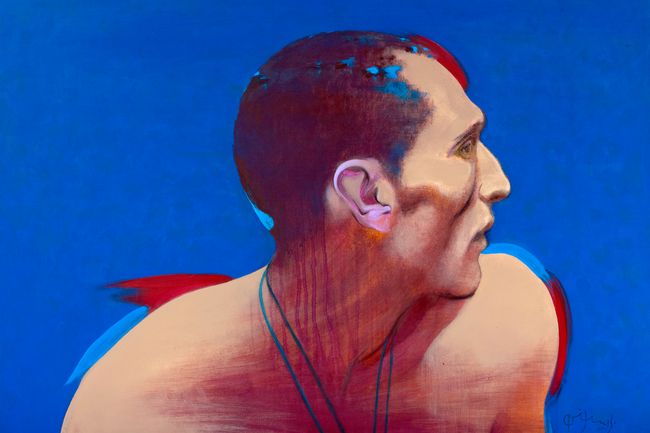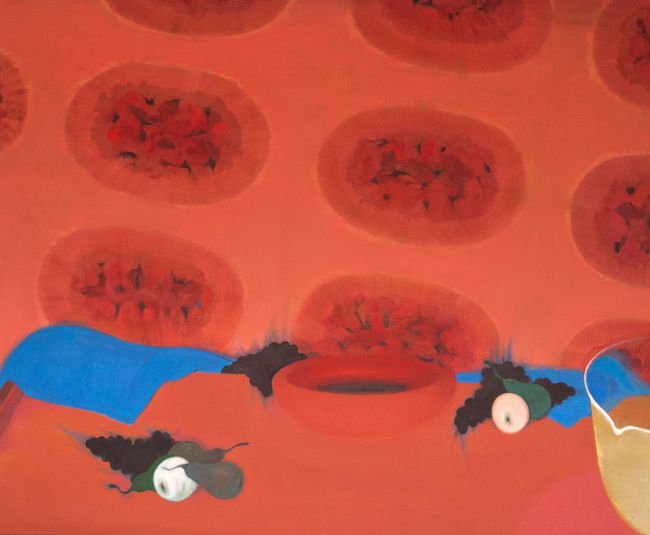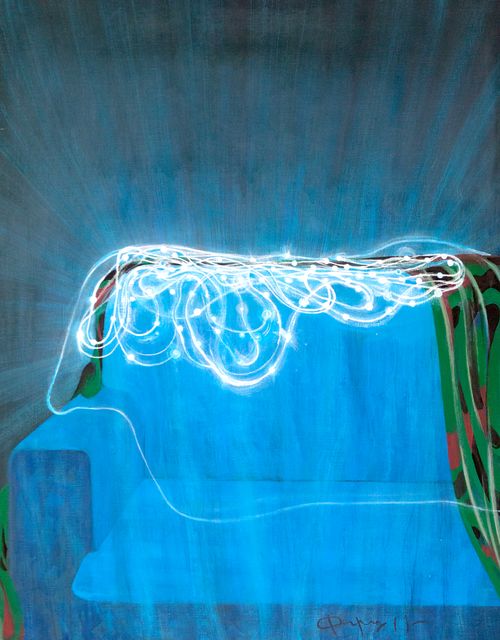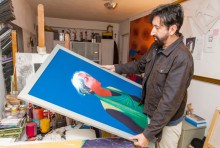Borys Firtsak was born in the village of Bilky, Zakarpattia Oblast. He graduated from Taras Shevchenko Republican Art School (Kyiv, 1979), and the Department of Print Design and Book Graphics at Ivan Fedorov Ukrainian Printing Institute (Lviv, 1984). As an artist, he has been invited to national and international exhibitions since 1987. He is also a member of BZH-ART Artists’ Association (2006) and Blue October art group. His artistic specialties include painting, drawing, stage design, and architectural design. His works are kept in private collections throughout Ukraine, Russia, Poland, the Czech Republic, Austria, the US.
BILKY
This is a town, which became a village in Soviet times. It has a rich history, Magdeburg Rights, a royal coat of arms, and a flag. The area itself is very picturesque, having raised many artists. Transcarpathia has always had a tradition for artists. Some even say that there are too many of them.
THE ENVIRONMENT
It had been the same as everyone else’s. School friends, after-school groups. But the main influence came from the father’s library and friends, and the travels with him. We used to spend a lot of time in Lviv, less so in Uzhhorod. In my childhood we had visited Prague, traveled across Czechoslovakia, the Baltic. I knew Tretyakov Gallery, the Hermitage, museums of Prague. Perhaps, this is a special experience of a Transcarpathian child.
STUDYING
My father was the first teacher. He used to dream of becoming an artist himself, but then the war happened and he had other things to do besides pursuing art education. But he had many fellow artists, including those of Transcarpathian school – for example, he was a friend of Zoltan Bakonii, a renowned teacher who had unique achievements for Soviet times, like being the founder of the “Young Artist,” the only recreation camp for writers and artists in the USSR. Among the children visiting the camp were people who became famous later – such as Pavlo Kerestei and Petro Midianka. I was lucky to be there on two rotations. I learned a lot from Stepan Hohola, my school teacher of drawing. But the Republican Art School had left the strongest impact. It was the place where everything had begun for real.
THE TRANSCARPATHIAN SCHOOL
I cannot say that I have nothing to do with it, but I do not consider myself to be a part of it. Its main feature is the southern flavor, the sense of color, inherent to southerners living in places with more sun, as Transcarpathia had been a part of the Austro-Hungarian Empire, which stretched from the Carpathians to Venice.
COLOR
My color vision is bipolar, the poles being black-and-white and polychrome. Until recently, I had a very specific, cold, blue-green combination dominating through my art. But I cannot say that I prefer just one part of the spectrum.
I choose a certain color range depending on my inner state at the moment. I can write a realistic portrait, but with blue or green face. I don’t have a good, a bad, or the most favorite color. There is only a combination of colors and its usage depending on the purpose that I set for myself.
PERFECTIONISM
I can be thinking for a long time, or working for a long time, redrawing a painting or a single detail dozens of times, only to arrive to the inner state that would express the emotional, conceptual essence of what I want to paint.

MARGINAL. 2013
There are times when there is no fault to anything, but then another problem emerges: the painting becomes boring. It becomes very well done and thus loses its charm. It’s too bad. I go back and begin to look for the fine details, the nuances that were lost when I was smoothing out the painting. The work begins anew – essentially from scratch. There should be quality, because we are professionals, but if there are no intriguing details, the work seems lifeless, devoid of continuity. The painting is ready when it begins to live independently of the author. It is ready when you have nothing to add or to take away from it. It’s like a child that has grown up. No matter how good or bad it is, whether you love it or not – it lives by itself.
ESTRANGEMENT
I see myself as an artist; this sense of inner purpose had appeared at the time my character was maturing. But the image of an artist appears grotesque in the minds of a common person, in the minds of the whole society – that’s why I don’t like when people see me as an artist, although it is, perhaps, a thing difficult to hide.
SHAPE ABOVE ALL
I try to remain on the verge of abstraction and visual specifics. A work of art should be compositionally perfect as an abstract creation – it does not matter what is depicted there, what matters is how it is placed and what effect it has on the viewer. In this regard, I am an abstractionist.

Of course, there is a literary, semantic meaning – the theme, the plot, but it is secondary in painting. The shape is above everything else. Working with shape is more important than working on the plot. Actually, that’s why I’m having such difficulty with the perception of postmodernism, which, fortunately, gradually subsides in our country: there’s too much literature, one needs too much to know and to say, before they can look at and perceive the art. There is no contact, no direct communication.
THE “PATCHES” CYCLE (FABRIC AS THE PICTURES’ CENTRAL OBJECTS)
Draperies, clothing – they are repeating a person, but without the person itself. Like a plaster cast. They keep the contact with their owner, while the owner themselves is not present. That is like a literary, frivolous departure into a plastic abstraction. It’s a show of emotions through the flexibility of shapes. But generally it’s a traditional image. Ancient sculptors had painted draperies; Leonardo and other classics had many cool studies on that.
VINYL RECORDS
I painted a series of them – combined with draperies. A vinyl plate is a direct contact: live, sans digitizing, sans intermediaries, the sound mechanically transmitted. This is what the art has lost today. After all, we look at the artist’s work through literature, through the concept. As for the vinyl plate as an object – I believe, it’s a brilliant, concise, concentrated symbol of the era that passed away, a symbol of the lost direct connection between people and art.
NUDE ART

INTIME. 2013
I believe Pasolini said that nudity is always revolutionary. It is a true idea. A naked image is always the exam for the artist on the sense of modernity. Because getting rid of stereotypes that have developed in the genre over the millennia is very difficult. You have to be separate and independent to make it your own way. It is a challenge for yourself in the first place. I didn’t stop on female nudes; with sculptor Oleksandr Diachenko we made a project, which showed male nudity. We tried to express this plastic without rubber stamps, without the desire to please anyone. So to speak, we tried to shock people by not shocking them.
THE CHALLENGE
There are ideas that I really want to implement. There are secret, specific topics, which are interesting to express in my own, peculiar way. After all, every artist has their tricks, and they are limited. If you go beyond their limits, you lose your distinction from other authors. Many artists were spoiled by indulging their own image. From this arises the challenge – by your own modest means convincingly present something that others had done many times before you. For me, a constant challenge is presenting the object as it is, but in a way that the result would have as little objectivity and as most shape as possible.
THE COMPETITION
I am not concerned. Who can I compete with, who can compete with me? For what? One cannot compete with certain social circumstances. If you want to be liked, then you start to care more about it. Of course, a separate period of time in art has some competition – when everyone grows, learns, gains experience, convinces others of their maturity – but ultimately, only the art, good or bad, remains.
THEATER
I have no conflict between painting and set design, because in theater I’m trying to find situations that are consistent with my views. The theater comes to creative work only when the director and the set artist think alike. The scene is a collective work; one has to know a lot what an easel artist does not know. I know something in painting and graphics, but every new setting is another challenge for me, because it is a new play, a new author, on whom I depend. Sometimes it comes down to building a good set design, and the rest will come after it. But for me it is a kind of stimulus, because one kind of activity is not enough for me.
Switching to a different genre can be a recreation. I’ve worked with movies, worked as a book illustrator, even designed covers for the same vinyl plates, and Ivan Franko Theater knows me not as a set designer, but as a poster artist. I would engage in sculpture, but this is more a dream of mine. Painting is hard work, sculpture is even harder, one cannot simply dabble in it.
THE VIOLATION
Art is something that goes in spite of everything that there is; it goes contrary to the moral, social, aesthetic dogma, against social and religious doctrines. Only then it is able to develop. Some radical changes brought about by a lot of artists are invisible to the public, because they, as people say now, are not in the trend. They will be understood later.
You should not make bad paintings, you should respond to the situation. But it comes with the experience. Only when you falter, you know how to avoid the mistake for the next time. For me it is important not to indulge the desire to be liked. It is enough to like myself. Although, of course, it is difficult and does not always bring the feedback we all want – every artist wants to be known and understood. But perhaps every artist has their own time, their own critical mass of perception in society; accumulating it they become known. But that’s only in the perfect world. And for the time being we have to be liked by ourselves.
POVERTY
No one should be poor – not the artist, not anyone else. Everyone should live normally, so that we would have more energy to do favorite things. One does not become any more talented from poverty.
ADDICTION
There are moments when a person hates everything they do, even the most favorite kind of work is no exception. The question is why the artist continues their work despite fatigue and all that. This is addiction, albeit a positive one.
When I am tired, I wait for the tiredness to go away, or I switch to something else. Theater helps. To relax properly is also a special skill. I recently have tried to rest purposefully. I went to the sea and eventually hated the sea and the good weather, and the inexpensive restaurants; I fled there immediately. I had absolutely no rest; I came home angry and sick. And I gladly plunged into theatrical work.
I don’t know where the strength comes from. But is there anything to do except art?
HOBBY
I always have something to do. Perhaps doing nothing is my long-awaited hobby.








